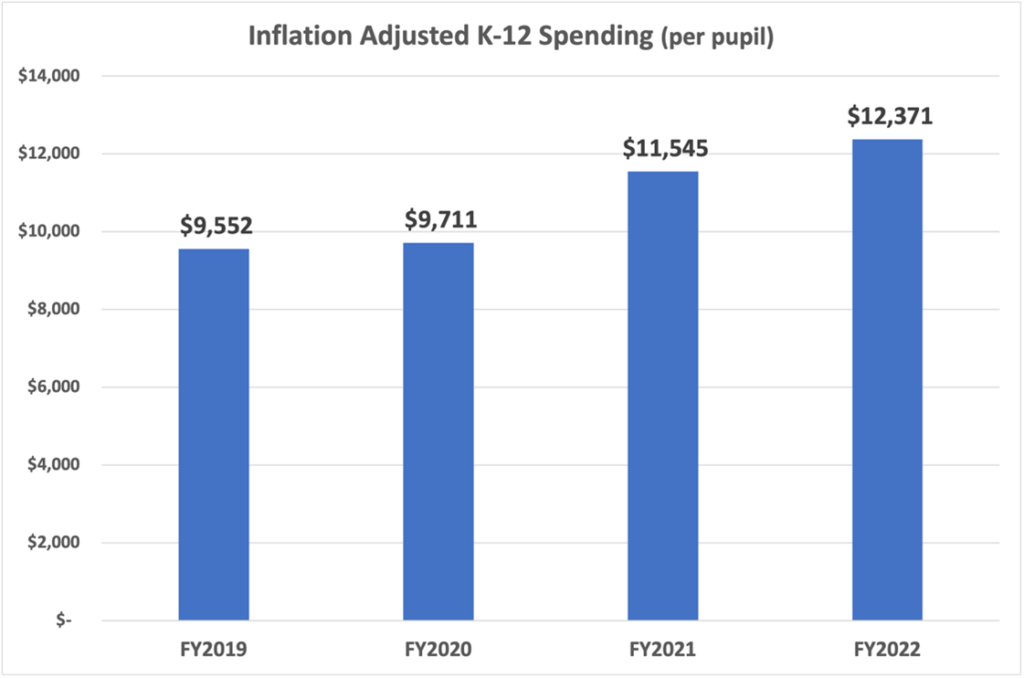For over a decade, Arizona Democrats and the education lobby have been beating the same K-12 drum that our schools are underfunded, spending is at historic lows, and that the legislature refuses to invest more in K-12. And every establishment media outlet and so-called “investigative journalist” in Arizona have been more than happy to parrot this narrative for them. Most articles and opinion columns published by the Arizona Republic read more like repackaged press releases from the Arizona Education Association than anything resembling a real news story.
But unfortunately for the Democrats and their pals in the media, the recent Arizona Supreme Court decision on Prop 208 just blew their K-12 funding narrative into pieces. Under the court’s 6-1 decision, the majority ruled that any revenue generated from the Prop 208 income tax surcharge is not exempt from the constitutional K-12 expenditure cap, so if the tax hike would cause K-12 funding to exceed the cap, then the measure is unconstitutional.
This shouldn’t be a problem, right? According to the backers of Prop 208 and the Media, we haven’t been properly funding K-12 for decades.
Yet the lone dissent in the decision referred to the majority opinion as “almost certainly dooming the measure.” Dooming the measure? If Republican lawmakers have truly slashed education funding, if we haven’t been properly funding K-12 for decades, how could we be hitting a constitutional spending limit that hasn’t been reached since 2008?
That’s because everything the education establishment and the media has been telling you about K-12 funding levels in Arizona has been one big lie. Education spending in Arizona is at an all-time high, and we know this because we are hitting the K-12 constitutional spending cap.
The K-12 Constitutional Spending Cap Explained
In 1980, Arizona voters approved a series of constitutional tax and spending reforms at the ballot. These reforms were a bipartisan effort to address concerns of reckless spending and skyrocketing property tax increases throughout the state. One of those approved reforms was a limit on the amount K-12 school districts were allowed to spend.
This expenditure limitation is not determined by partisans at the legislature and cannot be manipulated so that politicians can hide how much funding they are providing to K-12. It’s an objective, formula-based spending cap calculated by nonpartisan bean counters on the Economic Estimates Commission consisting of a representative from the Department of Revenue and two other economists.
It’s calculated like this: the Commission takes the funding baseline from the 1979-1980 budget year, adjusts it every year for both student population growth and inflation, and then adds an additional 10% on top. In other words, the spending cap has been allowed to grow annually for 40 years to include both population growth and inflation, plus an additional 10%.
Additionally, this cap doesn’t include multiple funding sources that have been exempted from the cap. For example, the hundreds of millions coming from the Federal Government through the Covid spending packages do not apply toward the expenditure limitation. So when the cap is reached, Arizona taxpayers will know—based on an objective measurement—that K-12 spending is at a historic high.
The Economic Estimates Commission estimates that the education spending cap for FY 2022 will be just over $6 billion. Based on the recently enacted budget, we anticipate that Arizona will exceed the cap, which is why we expect Prop 208 to be ruled unconstitutional and struck down later this year.
Some may be asking: did the backers of Prop 208 know that their measure may trigger the education spending cap, thus tossing their measure into legal jeopardy? Perhaps they were believing their own press clippings about schools being underfunded?
This is the part that should make taxpayers’ blood boil. Not only did the education lobby know that 208 would trigger the expenditure limitation, but snuck language into their ballot measure to sidestep the cap by calling the tax surcharge revenue a “grant.”
That’s right—while they were selling the public on the myth that schools are underfunded and that we need to tax the “rich”, their lawyers concocted a legal strategy to sell judges on the idea that their tax is really a “grant” to avoid hitting a spending cap they knew we were going to hit.

Fortunately for taxpayers and small business owners, the Supreme Court saw through their scam and didn’t come up with some sort of John Roberts-style legal reasoning to save the measure.
One would hope that the education left would have learned a hard lesson from this blunder, but don’t count on it. Instead, their strategy seems to be gaslighting the public into thinking the expenditure limitation is archaic because it was set in 1980. Spreading falsehoods is almost second nature to them. Remember, these are the same people that claimed 208 wasn’t a tax on small business, yet have turned around and sued over SB 1783 because it might prevent small business owners from paying the 208 tax.
Until now the left has believed they can promote false narratives, with the help of the media, about K-12 funding and get away with it. Not anymore – the jig is up, and the lies have been exposed. K-12 funding is at record high levels and because of that, the Arizona Supreme Court decision will likely sink Prop 208 and take this narrative down with it.
Help Protect Freedom in Arizona by Joining Our Grassroots Network
Arizona needs to have a unified voice promoting economic freedom and prosperity, and the Free Enterprise Club is committed to making that happen. But we can’t do it alone. We need YOU!
Join our FREE Grassroots Action List to stay up to date on the latest battles against big government and how YOU can help influence crucial bills at the Arizona State Legislature.


Recent Comments